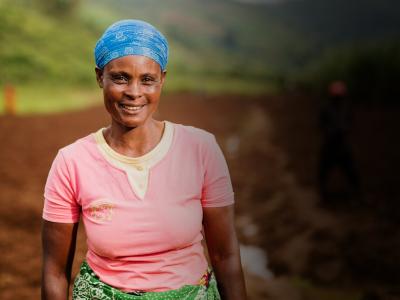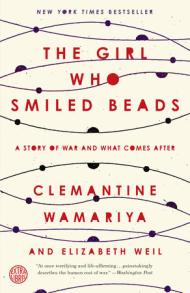Welcome to the Women for Women International Book Club! On Instagram, we asked you to vote on which book we should read this May, and you picked The Girl Who Smiled Beads: A Story of War and What Comes After by Clemantine Wamariya and Elizabeth Weil. Clemantine, the author and narrator of the book, recalls her childhood as a refugee of the massacre in Rwanda and the experience of piecing together her story in the aftermath.
What is The Girl Who Smiled Beads about?
In The Girl Who Smiled Beads*, Clemantine shares her story of a childhood stolen when conflict in Rwanda forced her and her older sister, Claire, to become refugees. Over the span of six years and seven countries, the two sisters survive hardship after hardship, including danger from those who promised to care for them.
Clemantine pieces together her deeply personal story, alternating between her experiences wandering central and southern Africa and her time in the United States. Throughout her account, Clemantine provides an honest perspective on the human potential for violence, the shortcomings of humanitarian aid, and the expectations placed on survivors to perform.
As Clemantine reflects on her experiences, she returns to a tale told by her nanny of a girl who smiled beads and the power of defining what happens next in one’s story.
*Trigger warning: sexual assault, child abuse, war and violence
Discussion Questions
Check out the discussion questions below and connect with readers on Instagram to share your reactions, thoughts and questions by using the hashtag #WFWIBookClub, and tagging us with @womenforwomen. We want to hear what you think—share with us your take on the book!
-
Storytelling is a recurring theme in The Girl Who Smiled Beads. Who are the important figures in Clematine’s life who share stories with her and why are they so important to her throughout her journey?
-
The authors write: "In Rwanda, if you’re female, you are born with great value—not because of who you are as an individual or your mind, but because of your body." What does this statement mean to you? Have you ever felt this way in your own culture?
-
As sisters, Claire and Clemantine came from the same family and circumstances, but their lives as refugees were profoundly different. What were some factors that contributed to such different experiences?
-
What are a few survival tactics that Clemantine developed to cope with life as a refugee? How did they continue to impact Clematine as an independent adult?
-
Clemantine expresses skepticism of giving from both individuals and organizations, and the power imbalance for those receive. How does the book depict examples of giving that preserve dignity? How can people support each other without creating these imbalances?
-
Clemantine planned a European trip for herself and her mother to experience together. In what ways was she disappointed by the trip? In what ways did she and her mother bond?
-
What examples did Clemantine provide to illustrate how Rwandans are collectively choosing to come together and overcome their shared, traumatic past?

